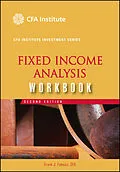In this fully revised and updated Second Edition of Fixed Income Analysis, readers will be introduced to a variety of important fixed income analysis issues, including the general principles of credit analysis, term structure and volatility of interest rates, and valuing bonds with embedded options.
Autorentext
FRANK J. FABOZZI, PHD, CFA, CFP, is an Adjunct Professor of Finance and Becton Fellow at Yale University's School of Management. He is also Editor of the Journal of Portfolio Management and a consultant.
Klappentext
In the Second Edition of Fixed Income Analysis, financial expert Frank Fabozzi and a team of knowledgeable contributors provide complete coverage of the most important issues in fixed income analysis.
Now, in Fixed Income Analysis Workbook, Second Edition, Fabozzi offers you a wealth of practical information and exercises that will solidify your understanding of the tools and techniques associated with this discipline. This comprehensive study guidewhich parallels the main book chapter by chaptercontains challenging problems and a complete set of solutions as well as concise learning outcome statements and summary overviews.
If you want to make the most of your time in the fixed income marketplace, the lessons within this workbook can show you how. Topics reviewed include:
- The risks associated with investing in fixed income securities
- The fundamentals of valuation and interest rate risk
- The features of structured productssuch as mortgage-backed securities and asset-backed securities
- The principles of credit analysis
- The valuation of fixed income securities with embedded options
Zusammenfassung
In this fully revised and updated Second Edition of Fixed Income Analysis, readers will be introduced to a variety of important fixed income analysis issues, including the general principles of credit analysis, term structure and volatility of interest rates, and valuing bonds with embedded options.
Inhalt
PART I Learning Outcomes, Summary Overview, and Problems
CHAPTER 1 Features of Debt Securities 3
Learning Outcomes 3
Summary Overview 3
Problems 5
CHAPTER 2 Risks Associated with Investing in Bonds 8
Learning Outcomes 8
Summary Overview 9
Problems 11
CHAPTER 3 Overview of Bond Sectors and Instruments 15
Learning Outcomes 15
Summary Overview 16
Problems 19
CHAPTER 4 Understanding Yield Spreads 22
Learning Outcomes 22
Summary Overview 23
Problems 25
CHAPTER 5 Introduction to the Valuation of Debt Securities 29
Learning Outcomes 29
Summary Overview 29
Problems 31
CHAPTER 6 Yield Measures, Spot Rates, and Forward Rates 33
Learning Outcomes 33
Summary Overview 34
Problems 35
CHAPTER 7 Introduction to the Measurement of Interest Rate Risk 41
Learning Outcomes 41
Summary Overview 42
Problems 44
CHAPTER 8 Term Structure and Volatility of Interest Rates 49
Learning Outcomes 49
Summary Overview 49
Problems 52
CHAPTER 9 Valuing Bonds with Embedded Options 55
Learning Outcomes 55
Summary Overview 55
Problems 58
CHAPTER 10 Mortgage-Backed Sector of the BondMarket 63
Learning Outcomes 63
Summary Overview 63
Problems 65
CHAPTER 11 Asset-Backed Sector of the BondMarket 73
Learning Outcomes 73
Summary Overview 73
Problems 78
CHAPTER 12 ValuingMortgage-Backed and Asset-Backed Securities 83
Learning Outcomes 83
Summary Overview 83
Problems 86
CHAPTER 13 Interest Rate Derivative Instruments 92
Learning Outcomes 92
Summary Overview 92
Problems 94
CHAPTER 14 Valuation of Interest Rate Derivative Instruments 98
Learning Outcomes 98
Summary Overview 99
Problems 100
CHAPTER 15 General Principles of Credit Analysis 106
Learning Outcomes 106
Summary Overview 107
Problems 109
CHAPTER 16 Introduction to Bond Portfolio Management 114
Learning Outcomes 114
Summary Overview 114
Problems 116
CHAPTER 17 Measuring a Portfolio's Risk Profile 119
Learning Outcomes 119
Summary Overview 120
Problems 122
CHAPTER 18 Managing Funds Against a Bond Market Index 129
Learning Outcomes 129
Summary Overview 130
Problems 132
CHAPTER 19 Portfolio Immunization and Cash Flow Matching 140
Learning Outcomes 140
Summary Overview 140
Problems 142
CHAPTER 20 Relative-ValueMethodologies for Global Credit Bond Portfolio Management 144
Learning Outcomes 144
Summary Overview 144
Problems 146
CHAPTER 21 International Bond Portfolio Management 151
Learning Outcomes 151
Summary Overview 152
Problems 155
CHAPTER 22 Controlling Interest Rate Risk with Derivatives 159
Learning Outcomes 159
Summary Overview 160
Problems 162
CHAPTER 23 HedgingMortgage Securities to Capture Relative Value 167
Learning Outcomes 167
Summary Overview 167
Problems 169
CHAPTER 24 Credit Derivatives in Bond Portfolio Management 172
Learning Outcomes 172
Summary Overvie...
